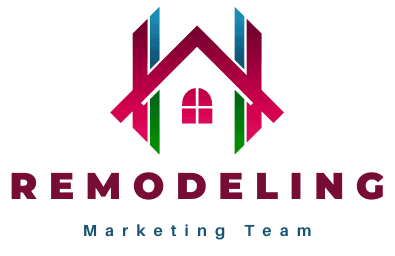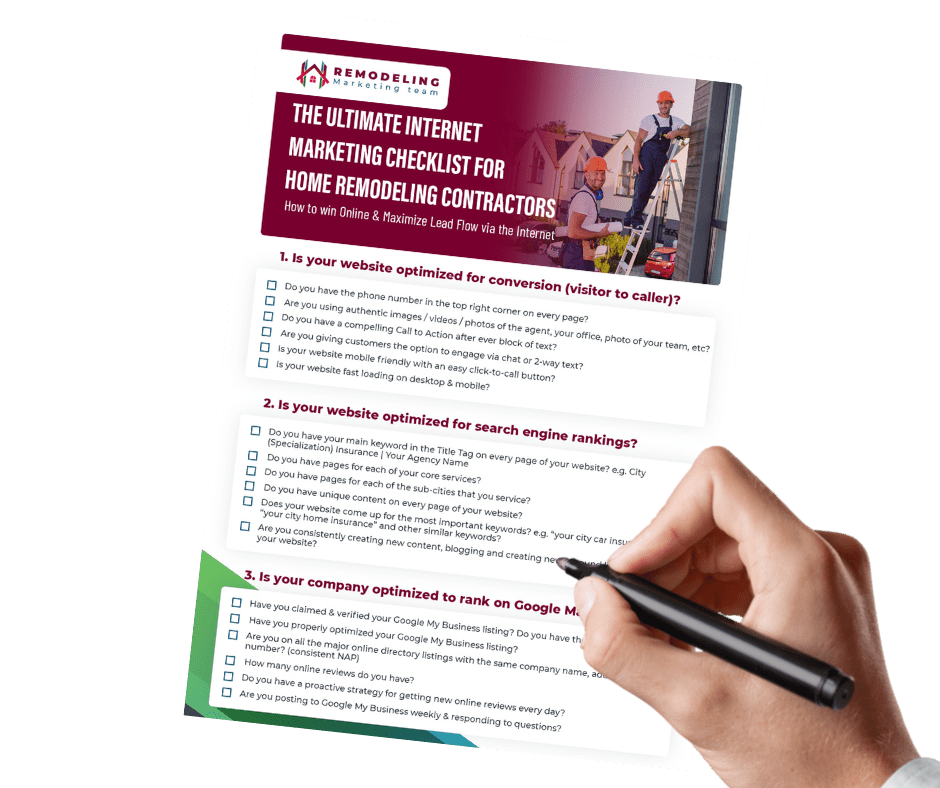Are You Throwing Money at Marketing Without Knowing What Works?
Are you spending thousands on marketing but unsure if it’s actually bringing in business? Many home remodelers face this challenge—investing in ads, social media, and SEO without a clear way to measure success. Without tracking the right data, you could be throwing money away instead of building a predictable lead-generation system.
Successful remodelers don’t guess—they measure, analyze, and refine. This guide will walk you through the key performance indicators (KPIs) that determine marketing success, the best tools for tracking results, and how to use data to fine-tune your approach. By following these principles, you’ll maximize your marketing dollars and generate higher-quality leads.
Key Takeaways: Data-Driven Marketing for Home Remodelers
- Marketing Without Data Leads to Wasted Money
- Many home remodelers invest in ads, SEO, and social media without tracking results, leading to inefficient spending.
- Successful businesses rely on measurable data to guide their marketing decisions.
- Tracking the Right KPIs Improves Performance
- Key Performance Indicators (KPIs) such as website traffic, conversion rates, and cost per lead help remodelers determine which strategies are working.
- Regularly monitoring these metrics allows for continuous improvement and better ROI.
- The Right Tools Simplify Marketing Measurement
- Google Analytics, Google Search Console, SEMrush, Hootsuite, and CRM platforms help remodelers track and optimize their marketing efforts.
- Using multiple tools together provides a comprehensive view of performance.
- Data Should Drive Adjustments in Marketing Strategy
- Businesses should refine underperforming campaigns, shift budgets toward high-performing channels, and continuously test new approaches.
- Example: If paid ads generate expensive leads, adjusting targeting and ad copy can reduce costs.
- Lead Nurturing and Follow-Up Processes Matter
- Data can reveal where leads drop off in the sales funnel, helping remodelers improve follow-ups and increase conversions.
- Example: Adding automated email sequences can improve appointment booking rates.
- SEO and Paid Ads Should Work Together
- SEO builds long-term visibility, while paid ads provide immediate traffic.
- Tracking keyword performance and lead sources helps remodelers balance both strategies effectively.
- A Strong Call to Action Increases Conversions
- Every marketing channel (website, email, social media) should have clear, compelling CTAs that guide potential customers toward taking action.
- Marketing Optimization Is an Ongoing Process
- Regularly reviewing KPIs, testing new strategies, and refining messaging ensures continued marketing success.
Key Performance Indicators (KPIs) That Matter
Tracking the right KPIs allows remodelers to identify which marketing strategies are working and which need improvement. Without these insights, businesses risk spending money on advertising channels that fail to convert. The most successful companies use KPIs to refine their marketing efforts and increase profitability.
1. Website Traffic & Sources
- Measures how many visitors come to your website and where they originate (organic search, paid ads, social media, referrals).
- How to track it: Use Google Analytics to segment traffic sources.
- Example: A home remodeler in Denver notices that most website visitors come from Facebook ads, but organic search brings in more qualified leads. By shifting focus to SEO, they lower their ad costs while maintaining steady inquiries.
2. Conversion Rates
- Tracks the percentage of website visitors who take action (filling out a form, calling, or scheduling a consultation).
- How to track it: Set up conversion tracking in Google Analytics to monitor contact form submissions and phone calls.
- Example: A remodeling firm in Texas sees a high bounce rate on their landing page. After simplifying the design and adding a stronger call-to-action, conversions increase by 25%.
3. Lead Sources
- Identifies whether leads come from Google searches, paid ads, referrals, or social media.
- How to track it: Use Google Analytics and CRM software like HubSpot or Salesforce.
- Example: A kitchen remodeler realizes that referrals drive the highest conversions. They launch a referral incentive program and see a 40% increase in word-of-mouth leads.
4. Cost Per Lead (CPL) & Cost Per Acquisition (CPA)
- Determines how much it costs to generate a lead and convert them into a paying customer.
- How to track it: Divide total marketing spend by the number of leads acquired.
- Example: A contractor running Google Ads finds that their CPL is too high. By refining their ad targeting and optimizing landing pages, they lower CPL by 30%.
5. Search Engine Rankings & Keywords
- Monitors how well your website ranks for key remodeling-related search terms.
- How to track it: Use Google Search Console and SEO tools like SEMrush or Ahrefs.
- Example: A home improvement company in Chicago discovers that competitors rank higher for “bathroom remodel near me.” They invest in content marketing and backlink building to improve rankings.
6. Customer Lifetime Value (CLV)
- Estimates the total revenue a business can expect from a single customer over time.
- How to track it: Multiply the average purchase value by the number of repeat transactions.
- Example: A remodeling business realizes that repeat customers generate the most revenue. They introduce an email marketing campaign to encourage past clients to book additional services.
The Best Tools for Measuring Marketing Performance
Using the right tools simplifies tracking and improves decision-making. Instead of guessing which marketing efforts work, these tools provide real-time data so remodelers can adjust their strategies for maximum impact.
1. Google Analytics
- Tracks website traffic, user behavior, and conversion rates.
- How to use it: Identify which pages keep visitors engaged and which lead sources generate the most leads.
- Example: A remodeling company analyzes their website traffic and finds that mobile users leave the site quickly. They optimize the mobile experience, lowering bounce rates.
2. Google Search Console
- Provides insights into keyword rankings, website search performance, and indexing issues.
- How to use it: Track which keywords drive traffic and optimize underperforming pages.
- Example: A contractor notices a drop in organic traffic. Google Search Console reveals that key pages have lost rankings, prompting an SEO update.
3. Mailchimp or HubSpot
- Measures email marketing engagement and automation effectiveness.
- How to use it: Monitor open and click-through rates to improve subject lines and content.
- Example: A remodeler sends a monthly newsletter. After A/B testing subject lines, email open rates increase by 20%.
4. SEMrush or Ahrefs
- Analyzes SEO performance, backlinks, and competitor strategies.
- How to use it: Compare rankings with competitors and find new keyword opportunities.
- Example: A remodeling business finds that competitors rank higher due to strong backlinks. They launch a backlink outreach campaign and improve their rankings.
5. Hootsuite
- Manages social media marketing and engagement metrics.
- How to use it: Track which social media posts drive the most engagement and refine content accordingly.
- Example: A remodeling company posts weekly on Instagram but sees little engagement. Hootsuite analytics reveal the best posting times, leading to a 50% increase in interactions.
6. Salesforce Marketing Cloud
- Tracks lead generation, automation, and customer relationship management.
- How to use it: Automate follow-ups and nurture leads through email sequences.
- Example: A remodeler automates follow-up emails for leads who request quotes. This increases their conversion rate by 15%.
How Can Home Remodelers Use Data to Improve Their Marketing?
Marketing success isn’t just about gathering data—it’s about using it to make profitable adjustments. Here’s how to apply insights effectively:
- Identify Low-Converting Pages
- If visitors leave without taking action, test different calls-to-action and page layouts.
- Optimize Paid Ads
- Track which ads bring in the most leads and eliminate underperforming campaigns.
- Boost SEO Performance
- Monitor keyword rankings and updatecontent to improve search visibility.
- Improve Lead Follow-Ups
- Analyze response times and follow-up rates to increase conversions.
Example: A remodeling company notices that 70% of leads drop off after an initial consultation request. By adding an automated follow-up email sequence, they increase booked appointments by 20%.
Final Thoughts: Build a Marketing System That Works
Home remodelers who rely on guesswork often waste money on ineffective marketing. By tracking the right KPIs, using the best tools, and making data-driven adjustments, businesses can create a predictable, scalable system for generating leads.
Stop wasting money on marketing that doesn’t work. Book a free strategy session today, and we’ll pinpoint exactly where your leads are coming from—and where you’re losing business. Walk away with a clear, data-driven marketing plan to grow your remodeling company. Limited spots available, so don’t wait!
Frequently Asked Questions (FAQs): Data-Driven Marketing for Home Remodelers
Why is tracking marketing data important for home remodelers?
Tracking marketing data helps remodelers understand which strategies are working, where leads are coming from, and how much each lead costs. Without data, businesses risk wasting money on ineffective advertising and missing out on profitable opportunities.
What are the most important marketing metrics (KPIs) for home remodeling businesses?
Some of the most crucial Key Performance Indicators (KPIs) include:
- Customer lifetime value (CLV)
- Website traffic and sources (organic search, paid ads, social media, referrals)
- Conversion rates (percentage of visitors who take action)
- Cost per lead (CPL) and cost per acquisition (CPA)
- Search engine rankings and keyword performance
How can I track where my leads are coming from?
Using Google Analytics, Google Search Console, and CRM tools like HubSpot or Salesforce can help track lead sources. You should also ask new customers how they found your business to verify online data.
What tools should I use to measure marketing success?
Home remodelers should use a combination of tools, including:
- Mailchimp or HubSpot – Tracks email marketing performance
- Google Analytics – Tracks website traffic and user behavior
- Google Search Console – Monitors keyword rankings and site performance
- SEMrush or Ahrefs – Helps with SEO and competitive analysis
- Hootsuite – Manages and tracks social media engagement
How can I improve my conversion rates?
If website visitors aren’t turning into leads, try:
- Using testimonials and trust signals (reviews, certifications, before/after photos)
- Simplifying landing pages and contact forms
- Adding clear calls-to-action (CTAs)
- Improving page load speed and mobile-friendliness
How do I lower my cost per lead (CPL) for paid ads?
To reduce CPL, consider:
- Retargeting past website visitors to improve engagement
- Refining your ad targeting to focus on high-intent buyers
- A/B testing different ad headlines and descriptions
- Optimizing landing pages to increase conversion rates
Should I focus on SEO or paid advertising?
Both are important for different reasons:
- A well-balanced marketing plan includes both strategies to maximize results.
- SEO is a long-term strategy that builds organic traffic and credibility.
- Paid advertising provides immediate results and can quickly generate leads.
What is the best way to follow up with leads?
Follow-up strategies should include:
- Offering a clear next step, such as a consultation or estimate
- Responding within 24 hours (faster response times increase conversions)
- Using automated email sequences for nurturing leads
- Tracking lead interactions through a CRM to personalize follow-ups
How often should I review my marketing data?
Marketing performance should be reviewed at least monthly, with adjustments made quarterly based on trends. However, businesses running paid ad campaigns should check performance weekly to optimize spending.






